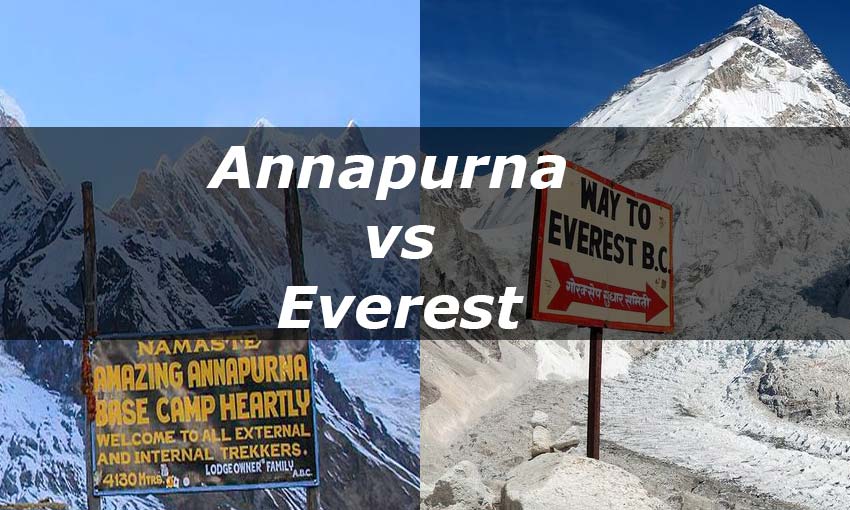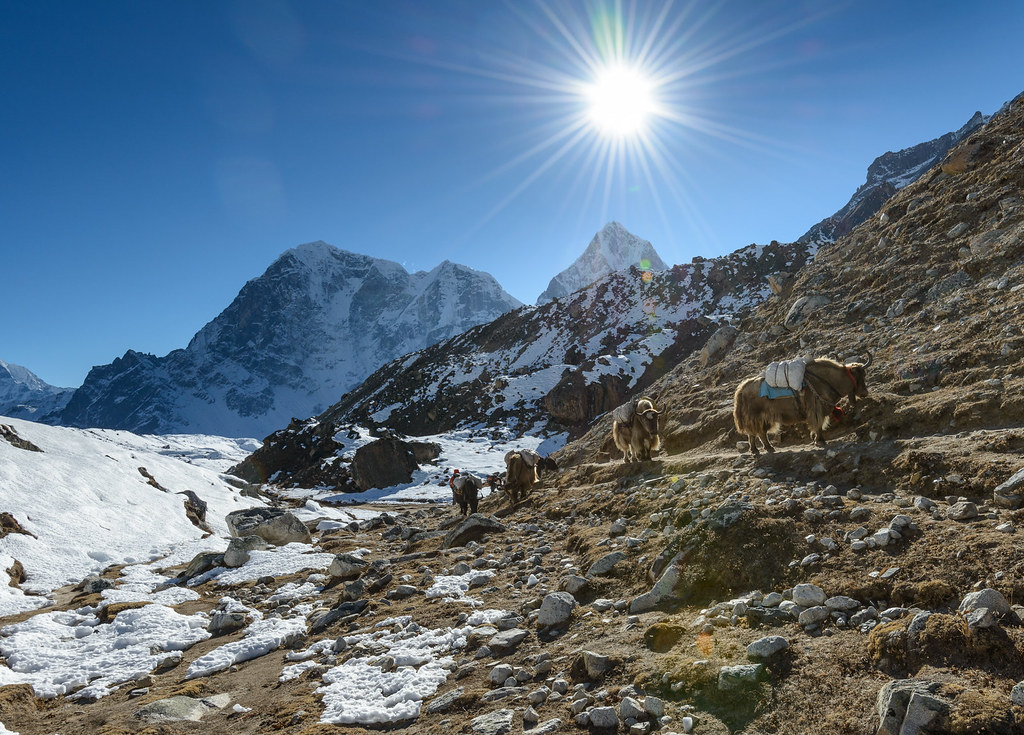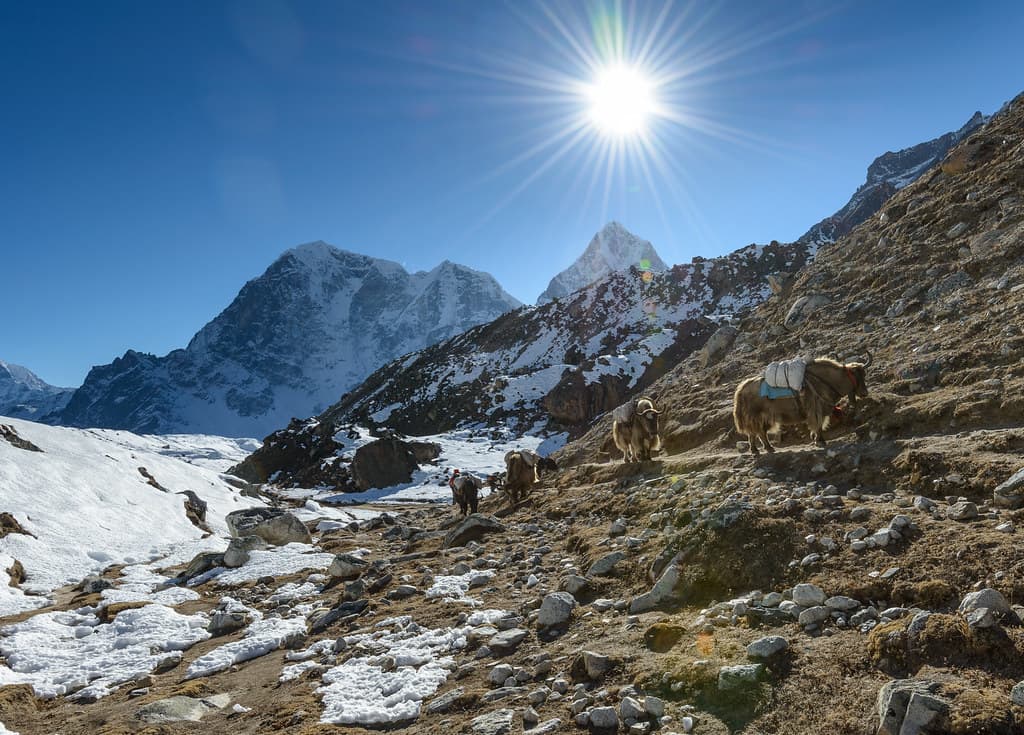- Annapurna Base Camp Trek vs Everest Base Camp Trek
- Weather at Annapurna Base Camp Trek vs Everest Base Camp Trek
- Crowds at Annapurna Base Camp Trek vs Everest Base Camp Trek
- Difficulties of Annapurna Base Camp Trek vs Everest Base Camp Trek
- Acclimatization at Annapurna Base Camp Trek vs Everest Base Camp Trek
- Accessibility of Annapurna Base Camp Trek vs Everest Base Camp Trek
- Cost of Annapurna Base Camp Trek vs Everest Base Camp Trek
- Preparation of Annapurna Base Camp Trek vs Everest Base Camp Trek
Who wouldn’t be delighted to travel places crammed with spectacular landscapes, deep fjords, lakeside villages, and ravines. But, wish if it was that easy to come up with a spot which stands out in every which way unless it was for Nepal. Here, we will compare the Annapurna Base Camp Trek vs Everest Base Camp Trek on different factors.

Small in terms of geographic distribution, Nepal is diverse in itself. It offers varied landforms, some thousand meters high above ground level, and others not even in the range of a hundred.
But, in spite of the discrepancy, if anything is common between these places then it’s their impressive view and local charm. As an abode to the Himalayas, it has no shortage of natural beauty and beautiful spots.
Visit the highlands and you’ll come across endless sky-scraping mountains which provides an awesome hiking trail. There are countless treks in the Himalaya which offer classic trails to traverse and explore the natural beauty.
But, despite so many of it, nothing can top the charm and eminence of Everest and Annapurna Base Camp. They are the most visited and also most imposing hikes of all with drop dead gorgeous views, rolling landscapes, and vivacious valleys.
Both are multi-day hikes but carry their own distinctive charisma and global reputation. While Everest Base Camp provides the splendid sight of glistening Mount Everest, Annapurna Base Camp delights with the mighty Annapurna massif.
With two headstrong and marvelous mountain treks in the world, it’s awful to pick one over the other. They both are exceptional in their own right with distinctive natural grandeur. Both Annapurna and Everest Base Camp trek have somewhat equal admirers.
Thus, it’s very hard to decide which one’s best between Annapurna Base Camp trek vs Everest Base Camp Trek. Therefore instead of choosing one, we’ll let you decide which one’s better than the other. To make it easy for you to judge, we have tote up complete information on Annapurna Base Camp Trek vs Everest Base Camp Trek.
Annapurna Base Camp Trek vs Everest Base Camp Trek
Not even in the wildest imagination can you think of trekking in Nepal without Everest Base Camp. It’s the most coveted hike in the world with eye-popping scenery, rolling hills, and snow-covered mountains.
The glory of Everest Base Camp is incomparable with trekkers from around the world dying to visit it for once. They are inquisitive to helm the trail and explore quaint villages sitting off to the side of trails.
Needless to say, Everest Base Camp Trek is more of climbing steep hills and less excursion. It’s quite a long walk to the camp, for the record 80 miles round trip back and forth Lukla. Thus, you’ll need a few technical skills and patience to complete the
On the contrary, Annapurna Base Camp is slightly easier and convenient than that of Everest Base Camp with a maximum elevation of 4,130 meters. Though the walk is no cakewalk with sufficient ups and downs, the difficulty level is not high either.
It’s a moderately paced hike, even though there are a few steep climbs and stone stairs to transcend. Walking the trail will find you with an unparalleled view of gigantic snow peaks and saddle.
The 2945-acres sanctuary, nestled on a glacial basin also provides visitors the view of endangered wild animals and birds. Trekkers can delve into the woods to see the overwhelming color palette of fall or full-bloom rhododendron in spring and autumn.
Annapurna Base Camp Trek is blessed with the most amazing panorama which will keep you occupied throughout the trek. It rewards the visitors with subalpine forest, enchanting villages, and snow-covered mountains that look sensational.
Walking the cliff is tiring but worth it as it will find you with the unrivaled view of Dhaulagiri and Annapurna. Visitors can spot numerous wildlife and birds while walking into the sanctuary.
Weather at Annapurna Base Camp Trek vs Everest Base Camp Trek
Everest Base Camp and Annapurna share pretty much the same kind of climatic conditions with every changing season. However, due to varied topography and altitude above sea level, the weather does differ in two base camps.
At 5,134 meters, the weather of Everest Base Camp is relatively colder at any typical day than Annapurna which soars up to 4,130 meters. The summer of Everest is distinct from the Annapurna Base Camp with a warm yet cold atmosphere.
Meanwhile, in Annapurna, the weather tends to be quite lovely with the bright sunshine day. The nights and mornings are somewhat frigid but not as much as on Everest Base Camp Trek. As expected, spring and autumn are the most fascinating time of the year.
To some extent, both base camp encounters mild weather in the months which makes it easy to navigate the trail. The sedative smell of wildflowers and fresh snow brought by a gust of wind on the trail is surreal.
During winter the weather at Everest Base Camp is a bit harsher than in Annapurna Base Camp. The temperature for the latter can go as low as -5 Degree Celsius in winter whereas, in Everest, it’s below -20 Degree Celsius.
Crowds at Annapurna Base Camp Trek vs Everest Base Camp Trek
When it comes to popularity amidst trekkers, there’s no noticeable difference between both Annapurna Base Camp and Everest. In fact, hikers show fair participation in each of the treks.
Nevertheless, due to more public interest and the priceless view along with sweeping landscapes, Everest is still at the top of the bill. Every year more than 40 thousand trekkers maneuver the trail of Khumbu Valley, hoping to reach Everest Base Camp.
The trail winding from Lukla is swarmed with hikers from miles across the world during the prime trekking season. Visitors literally juggle to find a room in teahouses and lodges unless reserved.
It doesn’t stop here as travelers most often get stuck in a traffic jam on the course between Phakding and Namche Bazaar. It all happens because the trails are pretty steep as you go higher and walking faster will cause altitude sickness.
It’s therefore, trekkers take slow steps which leads to the trail being crammed full. Winter and monsoon is the time when the hikers turn down base camp trek leaving the alley empty. You don’t have to fear accommodation and food during the month.
But the stress of walking a damp trail layered with snow and mud shall remain to disrupt. But it’s not just Everest Base Camp that has to combat such awful situations. Even Annapurna Base Camp has to deal with congestion during fall.
An overwhelming number of thrill-seekers roves the trek route of Annapurna, prompting the foothills to be jam-packed. Provided easy access from Tikhedhunga, the trail often stays busy and so is the dwelling.
However, as you climb high elevation, the mob disperse, resulting in the path to be hollow. In the last few years, a total of 25 thousand trekkers and more are recorded to visit Annapurna Base Camp each year.

Difficulties of Annapurna Base Camp Trek vs Everest Base Camp Trek
It may not come into attention but the difficulties of Annapurna Base Camp Trek vs Everest Base Camp Trek are quite striking. Starting off with the big and obvious, altitude sickness is a major concern of almost every Everest Base Camp hiker, unlike Annapurna.
Since the trail goes all the way up to 17,598 ft. high, trekkers are more likely to suffer from acute mountain sickness while trekking EBC than in Annapurna. They show up minor symptoms like headaches and dizziness which can then turn into extreme illnesses such as hypoxemia.
Simultaneously, the trail of Everest Base Camp is steeper as compared to the track of Annapurna Base Camp. It climbs peaks and troughs, passing through hills of Namche and plain meadow in Dingboche before arriving at the camp which is quite strenuous.
Another crisis that might arouse during Everest Base Camp Trek is accommodation and food. If you’re dropping round the camp during on-season, the dwellings are often occupied. If you’re thinking of booking the room at the last minute then just forget it.
As far as the trek difficulty level of Annapurna Base Camp is concerned, the hike is discreetly moderate with just a few rough terrains. It doesn’t require extreme physical fitness but trekkers must be in pretty good shape to cope with the rugged trails.
Although not as severe as Everest Base Camp but altitude sickness is still one of the most probable strains that trekkers of Annapurna Base Camp will have to encounter. Likewise, winter sees heavy snowfall on the way to Annapurna which makes it pretty hard for trekkers to scramble.
View: Everest Base Camp Difficulty
Acclimatization at Annapurna Base Camp Trek vs Everest Base Camp Trek
As the trail to Everest Base Camp is sheer and continuously rising upward, you’ll need to spare a few days for acclimatization. It’s done to adjust to the changing altitude and help trekkers avoid altitude sickness.
During Everest Base Camp trek, hikers take at least two days off to rest and accommodate with the temperature. The first acclimatization comes after reaching Namche Bazaar, where the trail is much precipitous.
Walking it now and then can make anyone feel dizzy which is why trekkers stop at the sherpa town to ease off. The next stop for acclimation during Everest Base Camp hike is Dingboche because after the village, the trail gains an elevation of 570 meters.
Meanwhile, for Annapurna Base Camp trek, travelers are recommended to take at least a day of rest. This will provide them the much needed time to familiarize with the temperature that falls with each elevation gain.
Since the effect of altitude is usually noticed after 2,500 meters above, trekkers can stopover at Deurali for acclimation. By doing so, they’ll prevent altitude sickness and easily climb the trail up to base camp.

Accessibility of Annapurna Base Camp Trek vs Everest Base Camp Trek
Annapurna Base Camp Trek vs Everest Base Camp Trek route is off-piste but not same at all. They walk different routes with discrepancies in difficulty level though both of them have quite a few ups and downs.
Everest Base Camp trek is accessible from Lukla where trekkers are supposed to reach out on a flight. The hike starts off with a gentle climb to the mountainside and the bank of Dudh Koshi river before Phakding.
From here, the trails are mostly uphill with rocks and stone stairways. It passes over several villages including Namche Bazaar and Tengboche which has a beautiful monastery. It’s built in Tibetan architectural style with a set of prehistoric statues and idols that gives a sense of pride.
The sights on the way to Everest Base Camp is as astounding as it appeared from the flight. The rock formations, lush-green pastures, fascinating hills, and mountains are impressive and sufficient to keep you busy throughout the trek.
It’s safe to say that Everest Base Camp has more ascending with a steep slope above Tengboche and even before. A lot of walks are over suspension bridges and through the dense forest filled with rhododendron, oak and birch.
Trekkers will have to come through Dingboche and navigate the rough route of Gorak Shep before the arrival of base camp. Perched at the foot of the Khumbu Glacier, Everest Base Camp offers a spectacular view of Mt. Everest alongside Nuptse and Ama Dablam.
You can also catch a glimpse of Khumbu Icefall and Ngozumpa glacier while exploring the camp. Prior to returning the trail, trekkers will make a quick walk to the nearest viewpoint Kala Patthar from where the scenery is wonderful.
It takes at least 2 weeks to complete Everest Base Camp trek but the duration of travel can be longer than this depending on itinerary. If you take an alternate route via Jiri, the hike will last about a month with almost a week to get to Lukla.
As for Annapurna Base Camp, the trek can be done in as little as 7 days or spend more than 2 weeks. The hike is certainly easier than walking Everest Base Camp. However, the trekkers are required to set aside enough time for climbing the trail and acclimatization.
The multi-day trek of Annapurna Base Camp typically kicks off with a short drive from Pokhara to Nayapul, followed by a trek to Tikhedhunga. As the trail winds uphill to Ghorepani, you’re sure to be exhausted but the exquisite view along the way will make up for it.
It then works its way through Tadapani and also makes a stop at Poon Hill. Located at an elevation of 3,210 meters, the hill station offers a breathtaking sunrise view and serene lakes of Pokhara overlooked by mountains.
The week-long trek passes several stunning villages including Sinuwa and Deurali to reach the campsite. No doubt, the winding trail is hard to beat with many highs and lows but the vista is still amazing as it keeps the mind fresh.
The trek route of Annapurna Base Camp boasts numerous monasteries, prayer flags, and Chortens to view. But it’s the sight from the base camp that warms the heart. Alone from the base camp at 4,130 meters, you’ll get a perfect shot of Annapurna massif as well as Manaslu, Gangapurna, and Pisang Peak.
The path climbing down to Pokhara comes across Sinuwa via Jhinu Danda Hot Spring where you can take a bath. Returning on the way, you’ll pass through dense forest full of pines and fir which is quite relaxing.
Cost of Annapurna Base Camp Trek vs Everest Base Camp Trek
The cost of Annapurna Base Camp Trek vs Everest Base Camp Trek is something that every avid trekker planning to visit Nepal goes over. They compare the outlay and sometimes make decisions counting on it.
But, most of the time, trekkers finalize the destination and then pay the charges that cover multiple expenses. If we compare the two treks, hiking Everest Base Camp is more exorbitant than Annapurna Base Camp.
Irrespective of other factors including itinerary and lavish life, the cost for Everest Base Camp trek is quite high. Trekkers shall be ready to pay anywhere from US$1,000 to US$3,000 for an average 7 to 21 days trek.
The cost includes roundtrip flight to and fro Lukla, permit for Sagarmatha National Park, accommodation, food and beverage. On the contrary, Annapurna Base Camp Trek cost ranges from US$800 to US$1200 for an average trek of 12 to 13 days.
The price covers all basic expenditures including ACAP entry permit fee, accommodations, porters and guides. However, if you need to use any facilities that haven’t been paid like hot showers and battery chargers, be ready to spend extra bucks.

Preparation of Annapurna Base Camp Trek vs Everest Base Camp Trek
Wondering how the preparation of Annapurna Base Camp Trek vs Everest Base Camp Trek is like or would they even differ from each other. Well, for your kind information, the preparation of Annapurna and Everest Base Camp doesn’t vary utterly but the prep for one is lesser than the other.
Being a moderate trekking Annapurna Base Camp Trek doesn’t demand extreme physical training before or even during the trek. Any beginner with strong physical health and self-control can do Annapurna Base Camp Trek with ease.
Of course, trekkers need to make sure that they can walk an average 5-6 hours each day but other than that there’s nothing much to worry. Hikers don’t need to have technical skills to do Annapurna Base Camp, so it’s pointless going through intense exercise.
Low-impact activities like jogging, nordic walking and cycling are quite enough for the preparation of trek. While shopping essentials, keep in mind which season you’re trekking and how the weather’s like during the time.
Your porters will only help you with the limited weight. So, don’t pick any random stuff and rather make a wise decision while buying treks gears. The porters on ABC trek can carry a weight up to 20 kg which is still more than the load transported by porters at Everest Base Camp.
Across the way is Everest Base Camp trek which too is easily doable but only if the hikers come well-prepared. Again there is no need of substantive skills for Everest Base Camp trek as well but the climbers must be out and about.
They not only have to be physically fit but also mentally strong to resist the strain. Walking 6-7 hours is no joke so they have to prepare their body accordingly. Unlike Annapurna Base Camp Trek, hikers have to do advance preparation for EBC which includes spending hours in the gym or doing short treks.
Trekking essentials are indeed the most important element of the trek so don’t neglect it. Don’t forget, weather plays a crucial role in the triumph or downfall of the trip so get the suitable items.
If you’re doing the trek in winter carry woolen clothes as it’s freezing cold in Everest Base Camp unlike Annapurna. See if the weight didn’t exceed 15 kg or else you’ll have to pay an extra amount for the excess weight to be carried by a porter.
You may also like:






